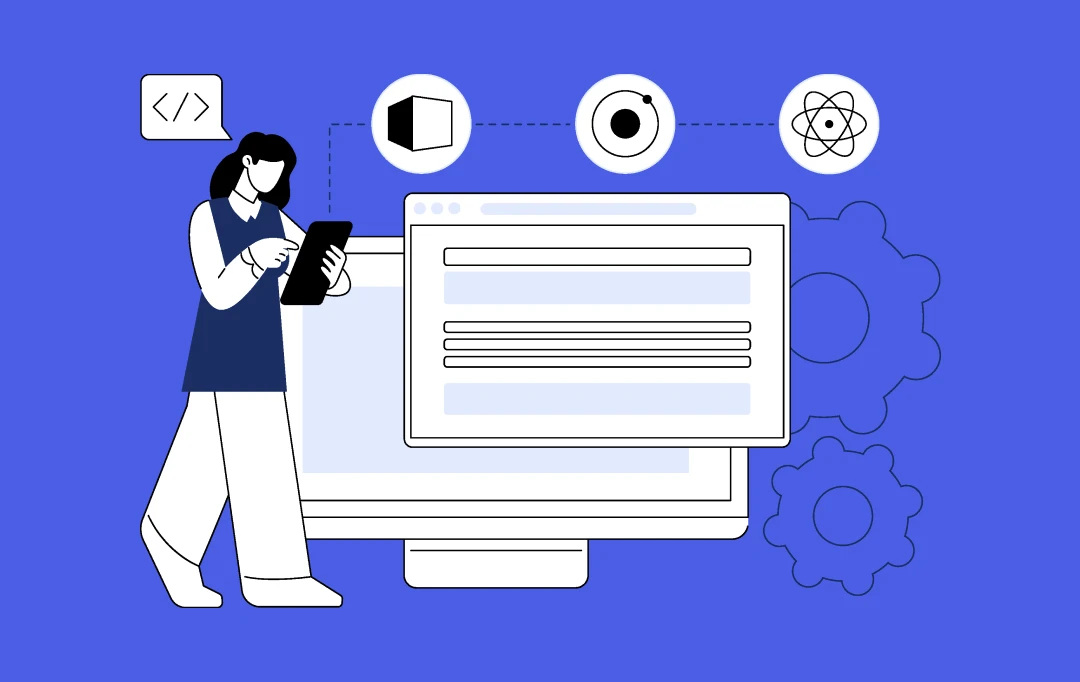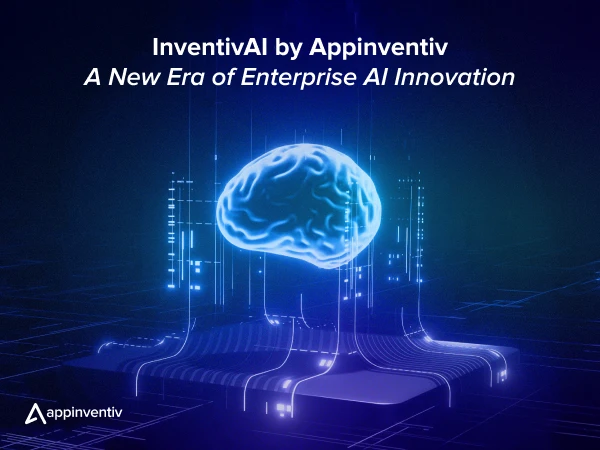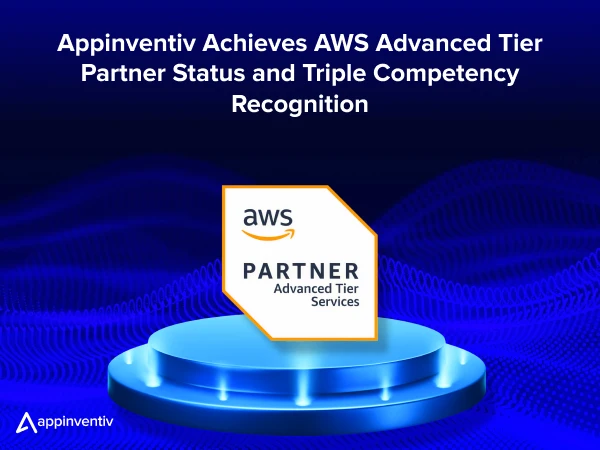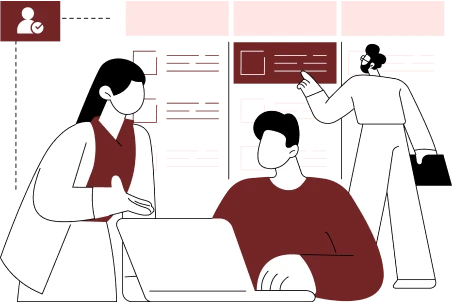- In-House Recruitment: Building Your Core Foundation
- A. Defining Characteristics and Features of the In-House Model
- B. Strategic Advantages for Business Leaders
- C. Considerations and Potential Challenges
- Staff Augmentation: Agile Expansion and Specialized Expertise
- A. Defining Characteristics and Features of the Staff Augmentation Model
- B. Strategic Advantages for Business Leaders
- C. Considerations and Potential Challenges
- Cost Comparison: Staff Augmentation vs. In-House Hiring (Which is More Cost-Effective?)
- Strategic Decision Framework: Choosing the Optimal Path
- A. Key Questions for Business Leaders
- B. The Power of a Hybrid Approach: Blending Strengths
- Partnering with Appinventiv: A Strategic Advantage for Talent Risk Management
- FAQs
Key takeaways:
- Cost Efficiency: Staff augmentation is less expensive when used in short-term projects, in contrast to in-house recruitment
- Scalability: Staff augmentation is swift at scaling teams, whereas in-house teams can be restricted
- Specialized Talent: With Augmentation, niche talent can be brought on at short notice; in-house is a long-term culture delivery mechanism.
- Control vs. Flexibility: The in-house teams are better in control, and the staff augmentation will provide flexibility in terms of external skills.
Digital transformation moves fast these days. One breakthrough can shift entire markets overnight, making your tech team’s agility absolutely crucial for staying ahead. Business leaders face a decision that goes far beyond typical HR considerations; it’s about strategic positioning of your team that touches everything from competitive edge to profit margins. The question that keeps executives awake? Staff Augmentation vs. In-House Hiring: which approach actually delivers results?
Consider the real costs of getting talent strategy wrong. Product launches stall when you can’t find the right skills. Market windows close while you’re stuck with inflexible team structures. Budgets spiral out of control from poor resource planning. These aren’t specifically operational hiccups; they’re reputation-damaging, investor-confidence-shaking events that can define your company’s trajectory for years.
Smart leaders get it. Building teams isn’t about checking boxes on job descriptions. It’s about crafting a workforce that can pivot quickly, innovate consistently, and deliver value while keeping costs in check. In today’s volatile business climate, that kind of strategic flexibility isn’t only nice to have; it’s survival.
This blog aims to equip leadership teams with the insights needed to make an informed decision that aligns perfectly with their strategic objectives.
In-House Recruitment: Building Your Core Foundation
Companies have traditionally relied on in-house recruitment as their primary method for building teams. This approach centers on bringing in full-time employees. These employees become genuinely integrated into the company’s culture and daily operations. This helps create long-term stability and ensures alignment with organizational goals.
Through this model, businesses can develop a core workforce. This workforce truly understands and represents the company’s values and strategic direction. Yet the pros and cons of in-house hiring extend well beyond cultural alignment. Companies must also weigh factors like expenses, growth potential, and response speed to shifting project requirements.
A. Defining Characteristics and Features of the In-House Model
When you hire in-house, you’re bringing people into your family. These aren’t exactly contractors passing through – they’re full-time team members who learn your ways, grow with your company, and become the backbone of everything you do.
- Direct Employment & Integration: At its core, in-house recruitment means hiring full-time employees. These employees are onboarded, trained, and managed directly by the organization. They become deeply embedded in the company’s hierarchy, processes, and daily operations. Think of them as the very bedrock of the company.
- Long-Term Investment: This model emphasizes a long-term commitment to the employee. Companies invest in their professional development. They offer clear career growth paths and strive for high retention rates. This focus on sustained engagement and growth is a defining element. It stands among the many features of In-House recruitment and Staff Augmentation models.
- Full Managerial Control: Organizations maintain absolute control over in-house staff. This includes their work, project direction, methodologies, and intellectual property development. This direct oversight ensures alignment with strategic vision and quality standards. It represents a huge plus for critical projects.
- Cultural Alignment: In-house hires are expected to assimilate into the established company culture. They actively contribute to it as well. This fosters a shared sense of purpose and enhances collaboration. It strengthens team cohesion, too. It’s about building a tribe that truly understands and lives the company’s mission.
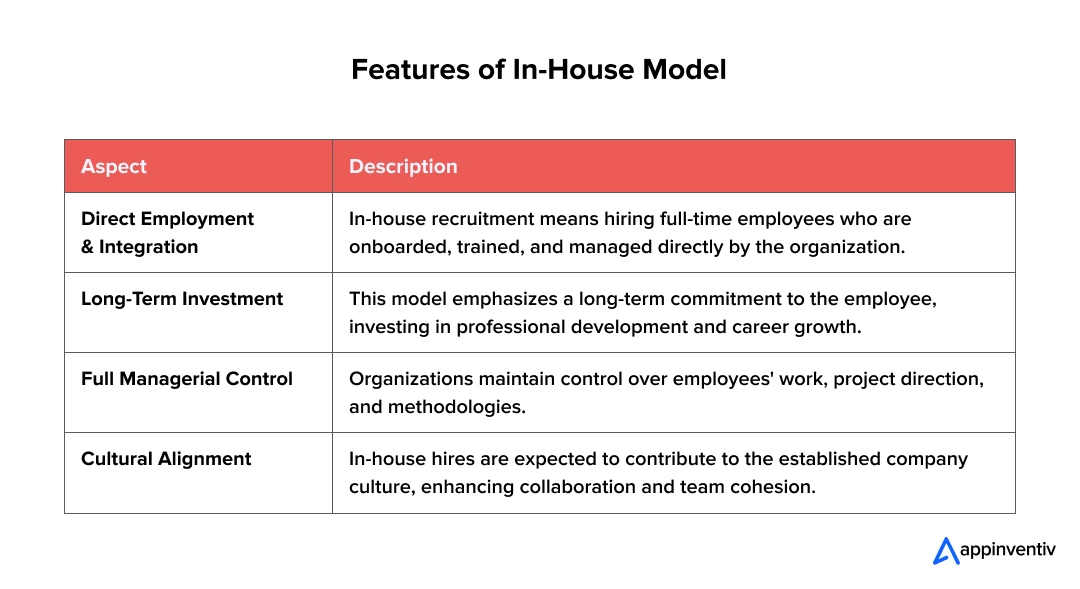
B. Strategic Advantages for Business Leaders
For business leaders, the strategic benefits of an in-house model often revolve around control, cohesion, and knowledge retention. Let’s break down why these matter in the broader context. We need to examine the Staff Augmentation Model vs. In-House Recruitment.
- Enhanced Control & Oversight: In-house teams provide organizations with incredible flexibility. They can set project parameters and tweak priorities at the last minute. They can mandate the maintenance of internal policy and security as well. This direct control is immensely valuable to mission-critical projects. It’s also crucial for projects that handle highly sensitive data. No outsourcing, no guessing.
- Deep Institutional Knowledge Retention: Every project contributes to growing organizational knowledge. Every challenge overcome adds to this foundation. Every lesson learned builds institutional wisdom within the organization. In-house teams become repositories of this accumulated expertise. This leads to greater efficiency in future projects and a significant reduction in learning curves. This accumulated expertise is a powerful long-term asset. It fosters continuous improvement and innovation from within.
- Stronger Team Cohesion & Loyalty: A stable in-house team fosters strong camaraderie and shared identity. This typically leads to better communication and more efficient problem-solving. It creates higher levels of commitment to company success. Employees often feel a personal stake in the outcomes. This drives greater dedication and overall quality.
- Investment in Core Competencies: For roles truly fundamental to a business’s unique value proposition, an in-house model works best. It’s essential for competitive advantage development, too. This model allows for deep expertise development and proprietary knowledge protection. This is absolutely crucial for developing intellectual property and truly differentiating market offerings. Such decisions are paramount when considering long-term impact. We must weigh outsourced development vs internal team capabilities carefully.
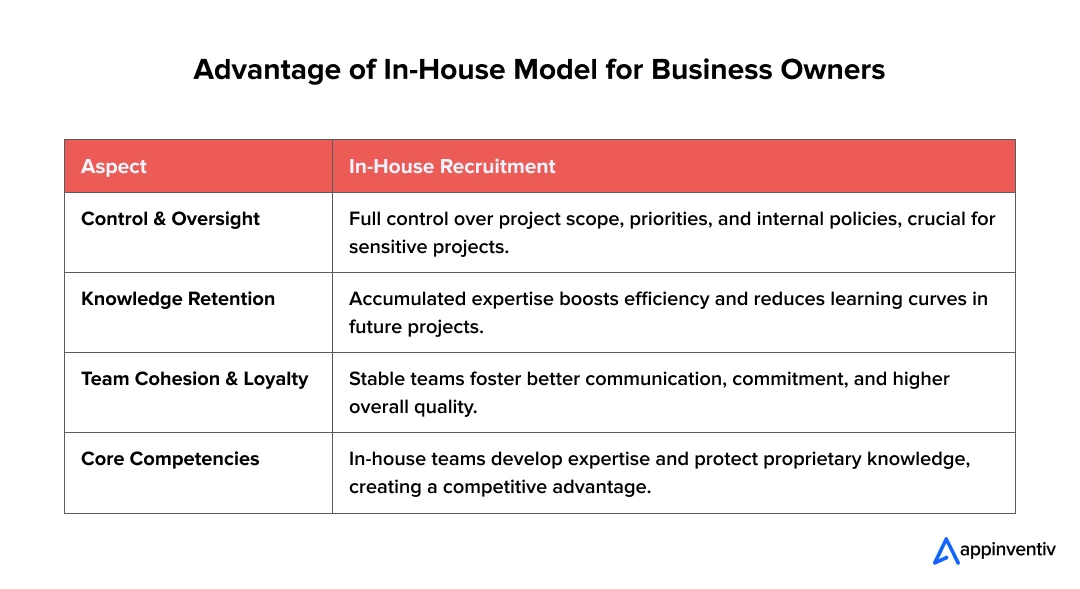
C. Considerations and Potential Challenges
While highly beneficial for core operations, in-house hiring does come with its own set of challenges. Leaders need to consider these carefully. These challenges often weigh heavily when comparing it with the alternative. This makes the discussion of IT Staff Augmentation vs. In-House Recruitment even more critical.
- Talent Shortages: One of the biggest hurdles is finding qualified candidates. You need people who possess the required technical skills. They must also align with your company culture and long-term vision. Unlike temporary or contract arrangements, in-house hiring requires finding individuals committed to your organization’s growth trajectory. This makes the selection process more complex and time-intensive.
- Lengthy and Resource-Intensive Recruitment Cycles: Identifying, attracting, interviewing, and onboarding top talent can be a real drag. In 2024, the average time to fill a position was approximately 44 days. This highlights the significant time this process can consume.
- Challenges in Rapid Scaling: Expanding or contracting an in-house team quickly can be cumbersome. This happens when meeting fluctuating demands or project cycles. It potentially leads to either underutilization of talent or employee burnout.
- High Turnover Costs: Even once a company finds skilled professionals, keeping them long-term can be difficult. Turnover can increase significant workloads for remaining staff, and can reduce employee morale. This impacts productivity and leads to the loss of essential skills.
Staff Augmentation: Agile Expansion and Specialized Expertise
Staff augmentation is a fairly adaptive method of recruiting people. It consists of incorporating external and skilled specialists into an established in-house staff on a fixed-term or project basis. These are experienced professionals who are under the direct supervision of the company employing their services, and are virtually extensions of their own staff.
We will now examine the key characteristics, features, pros and cons of staff augmentation in detail, offering a balanced perspective for informed decision-making.
A. Defining Characteristics and Features of the Staff Augmentation Model
Staff augmentation is like having a talent tap you can turn on and off as needed. Instead of hiring permanent employees, you bring in skilled professionals temporarily to boost your existing team’s capabilities. It’s the perfect solution when you need specific expertise fast, without the long-term commitment of traditional hiring.
- Flexible Resource Addition: Staff augmentation is designed for agility. It allows companies to quickly onboard skilled individuals to complement their existing team, whether to fill temporary skill gaps, handle peak workloads, or accelerate project timelines. Think of it as a plug-and-play solution for talent needs.
- Project-Based Engagement: This model is typically employed for specific projects, phases, or defined tasks. Once the project or need is complete, the engagement concludes, offering unparalleled flexibility. It’s ideal for those “sprint” scenarios. This inherent project-centric nature is a key differentiator in staff augmentation vs in-house hiring for IT projects.
- Access to Global Talent Pools: Staff augmentation benefits truly break down geographical barriers, providing access to a vast global network of highly specialized professionals. This capacity to tap into diverse talent pools globally comes out as a defining aspect when someone questions what is IT staff augmentation. This is particularly beneficial for niche technologies or when local talent is simply scarce.
- Client-Side Management: Importantly, augmented staff work under the internal project managers and team leads of the client instead of the vendor, as it is in traditional outsourcing. It implies that the client still maintains complete control over his/her daily activities, priorities, and/or inclusion into his/her work processes. It is literally an addition to a company team.
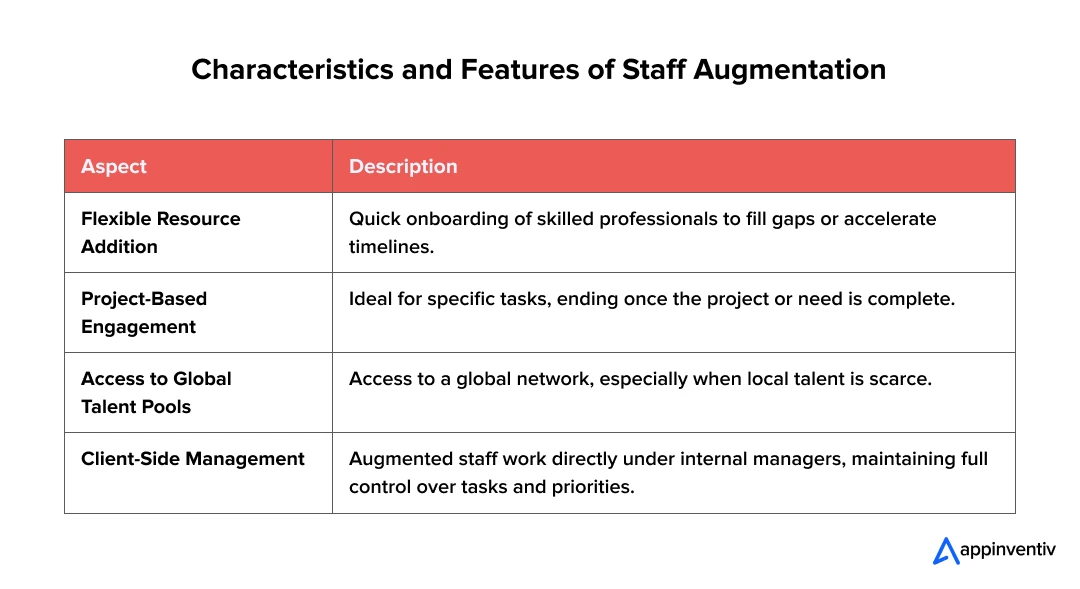
Also Read: An Entrepreneur’s Guide on Outsourcing Digital Transformation
B. Strategic Advantages for Business Leaders
For leadership teams, staff augmentation is a powerful tool for achieving speed, specialization, and significant cost efficiency. Let’s look at the upsides when evaluating IT Staff Augmentation.
- Rapid Scalability & Agility: When a new opportunity arises or a project needs immediate acceleration, staff augmentation allows a company to rapidly scale its team up or down. This agility means the organization can seize market opportunities faster and respond to changing demands without the long-term commitments of full-time hires. It’s about being nimble in a fast-paced market.
- Immediate Access to Niche Expertise: A company’s in-house team might excel in core technologies, but what about a sudden, urgent need for a blockchain developer, an AI/ML specialist, or an expert in a nascent framework? Staff augmentation benefits include providing instant access to these highly specialized skills, bridging critical gaps without the need for extensive internal training or a lengthy recruitment process, highlighting a key advantage in the Staff Augmentation vs. full-time Hiring debate.
- Reduced Operational Overhead: With the help of augmented staffing, an organization is likely to save a lot of money on paying indirect costs of full-time employment. This entails the evasion of costs incurred in the process of recruitment, benefits (health insurance, retirement), payroll taxes, office space, and continuous training. Basically, an organization does not make payment based on the overhead that it is accumulating, but rather the knowledge and performance that it is gaining.
- Focus on Core Business: With augmented staff handling specific project components or peak workloads, a company’s core in-house team can remain laser-focused on strategic initiatives, core product development, and fostering long-term innovation. This ensures the most valuable internal resources are always working on what matters most.
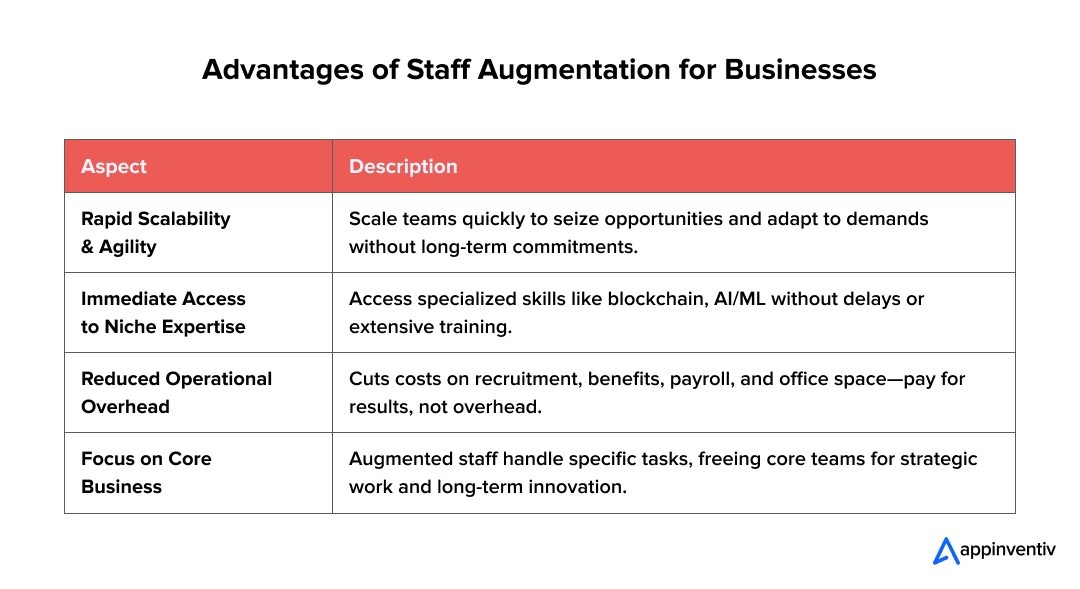
C. Considerations and Potential Challenges
While highly flexible, staff augmentation also requires careful management to be truly effective. Understanding these considerations is key to making an informed choice when assessing IT Staff Augmentation vs. In-House Recruitment.
- Ensuring seamless integration and communication with the existing team is key. A little effort here goes a long way.
- There’s potential for less cultural immersion compared to in-house hires, which needs to be managed through effective leadership and clear expectations.
- It requires robust contract management and clear service level agreements (SLAs) with the chosen staff augmentation provider. Dotting the i’s and crossing the t’s is important here.
Cost Comparison: Staff Augmentation vs. In-House Hiring (Which is More Cost-Effective?)
For business leaders and financial decision-makers, the ultimate question often boils down to cost-effectiveness. However, a true cost comparison goes far beyond simply comparing a salary to an hourly rate. It involves analyzing the total cost of ownership (TCO) for each model, considering both direct and indirect expenses, and factoring in the strategic value derived. Let’s compare the cost implications of the staff augmentation model vs. in-house recruitment.
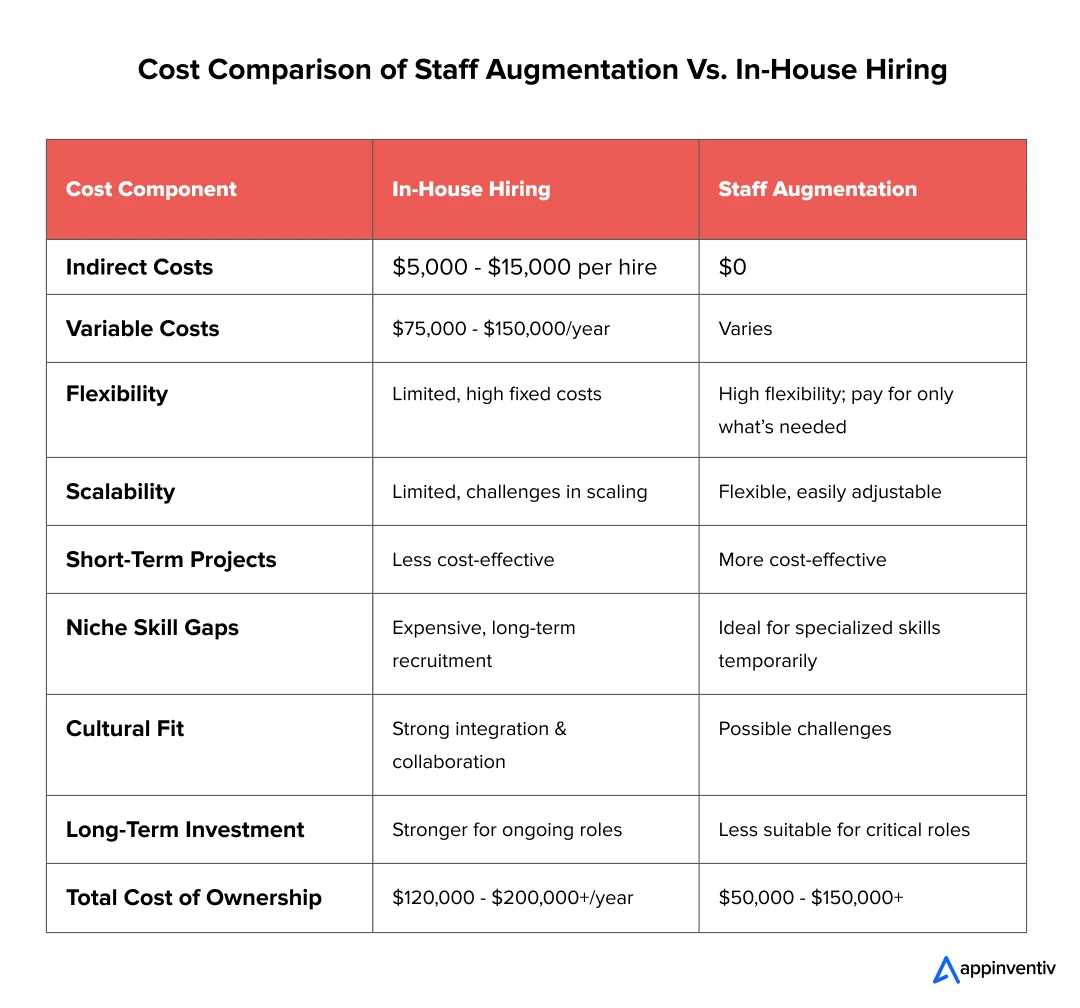
Ultimately, the “most cost-effective” model is the one that best supports an organization’s project goals while optimizing its resource allocation, considering both immediate expenditure and long-term strategic value. This critical balance is particularly pronounced when weighing staff augmentation vs in-house hiring for software development.
Bonus Read: Outsourced IT Support – Cost vs Benefits
Strategic Decision Framework: Choosing the Optimal Path
For business leaders and decision-makers, the choice between staff augmentation vs. traditional hiring is not a binary one. It requires a thoughtful assessment against several strategic criteria.
A. Key Questions for Business Leaders
Before committing to a talent strategy, a leadership team should ask these critical questions:
- Project Nature and Duration:
- Is this a core, ongoing initiative requiring continuous iteration and deep institutional knowledge? This leans toward In-House.
- Or is it a short-term, well-defined project with a specific deliverable and end date? This leans toward Staff Augmentation.
- Required Skill Set and Availability:
- Does the company need generalists for widely available skills? These skills should be central to its daily operations. This suggests In-House.
- Or does it need highly specialized, perhaps hard-to-find, niche experts for a limited duration? This points to Staff Augmentation. How critical is immediate access to this expertise?
- Budget Flexibility and Financial Risk Tolerance:
- Does the company prefer fixed, predictable costs with long-term liabilities? This indicates In-House.
- Or does it need variable, project-specific expenses with minimal long-term commitment? This approach optimizes cash flow and allows for rapid scaling. This suggests Staff Augmentation.
- Desired Control & Integration:
- How critical is full managerial control, direct cultural integration, and the accumulation of internal intellectual property? This points to In-House.
- Can the company effectively oversee a project with external experts? These experts integrate into existing workflows but retain their external employment status. This indicates Staff Augmentation.
- Time-to-Market Imperative:
- Can the company afford the time required for a traditional recruitment and onboarding process? This suggests In-House.
- Or does it need to quickly ramp up a team to seize a market opportunity or meet an aggressive deadline? This points to Staff Augmentation.
B. The Power of a Hybrid Approach: Blending Strengths
In many modern tech companies, the most effective strategy isn’t an either/or choice, but a nuanced hybrid model. This approach strategically combines the strengths of both in-house hiring and staff augmentation, creating a highly adaptable and resilient workforce for an organization.
- Leveraging Staff Augmentation for Agility and Specialization:
- Surge Capacity: Use augmented staff to handle sudden increases in workload, ensuring project timelines are met without overburdening permanent employees.
- New Technology Exploration: Bring in augmented experts to prototype, test, or implement new technologies without requiring the core team to undergo extensive, time-consuming training.
- Specific Project Phases: Utilize external specialists for particular phases of a project, such as initial architecture design, complex algorithm development, or final quality assurance, then release them once that phase is complete.
- Maintaining a Strong, Stable In-House Core:
- Strategic Leadership: Keep the most experienced and culturally aligned leaders, architects, and product managers in-house. They define the vision and maintain consistency.
- Core Product Development: The teams building the foundational products, intellectual property, and long-term services should ideally be in-house to foster deep knowledge and continuous improvement.
- Cultural Stewardship: The in-house team remains the heart of a company’s culture, driving internal values and ensuring cohesive collaboration.
Partnering with Appinventiv: A Strategic Advantage for Talent Risk Management
Successfully implementing staff augmentation requires more than just accessing external talent; it demands a partner with the expertise to navigate complex project requirements and mitigate inherent risks. The difference between a strategic advantage and a costly misstep often lies in choosing a provider with proven capabilities across diverse technical domains.
As a leading IT outsourcing services provider, our team at Appinventiv is uniquely positioned to help your organization address and mitigate the risks inherent in the staff augmentation model. With a formidable team of over 1,600 skilled professionals, we boast extensive expertise across the spectrum of IT outsourcing services. Our capabilities span mobile app development, custom software development, digital transformation, cloud computing, DevOps, data science & analytics, AI/ML, and blockchain solutions.
Our expertise has consistently demonstrated its ability to deliver innovative solutions across diverse industries, working with leading global clients to solve complex challenges. Our approach is marked by versatility and a keen understanding of each client’s unique needs. For example:
- KFC: We collaborated with this global fast-food giant to revolutionize its food delivery system, enhancing efficiency and customer satisfaction.
- IKEA: By working with this furniture retail leader, we played a key role in optimizing in-store experiences and improving operational processes.
- Adidas: We supported this major sports merchandise company in expanding its digital presence and engaging a wider audience, contributing to greater online visibility and sales.
In addition to their impactful work with clients, our commitment to excellence is showcased through prestigious accolades, including:
- Deloitte Technology Fast 50 India Awards winner in both 2023 and 2024.
- Recognized as an “App Development Company of the Year” by Entrepreneur.com.
We address every aspect of staff augmentation complexity, from security protocols to cultural integration, ensuring your projects succeed without compromising quality or timelines. Connect with our specialists to discuss how we can support your organization’s unique requirements.
FAQs
Q. When Should a Company Choose IT Staff Augmentation?
A. A firm can adopt IT staff augmentation in conditions of strict project schedule requirements, when there is a requirement to hire staff with specialized technology skills, or when the firm needs to ensure scalability and lower costs. It is perfect in the cases of short-term projects, like software development sprints, system updates, that are too slow or expensive to support with full-time employees. As an illustration, startups frequently extend teams to release apps swiftly, whereas enterprises can utilize it in niche proficiency. Successful onboarding guarantees a smooth integration, but handoffs to knowledge may need formalization.
Q. What Are the Risks of In-House Hiring over Staff Augmentation?
A. There is potential for increased expenses when using in-house hiring, such as salaries ($100,000+/year), benefits, and recruiting costs, as opposed to the temporary contracts used in staff augmentation that offer costs of around $50,000-$70,000. It is also slower because it typically takes months to onboard with projects, such as app launches being delayed. Fixed teams restrict flexibility to meet short-term demand, which may cause overstaffing. The cultural fit is more robust, and mis-hires can interfere with teamwork. Augmentation provides flexibility, although integration must be handled to prevent working issues, and it is riskier to consider in-house when working on urgent and specialized projects.
Q. Is Staff Augmentation More Cost-Effective than Hiring Full-Time Employees?
A. Staff augmentation is typically more cost-effective than hiring full-time employees for short-term or specialized IT projects. It eliminates long-term salary costs ($100,000+/year), benefits, and lengthy recruitment processes, with augmented staff costing $50,000-$70,000 for temporary contracts. For example, startups use augmentation to launch apps quickly without overhead. This clearly illustrates the cost dynamics of staff augmentation vs in-house hiring. Full-time hiring suits ongoing needs but is pricier for temporary workloads. Effective integration management is crucial to maximizing augmentation’s cost savings.
Q. What Are the Challenges of Managing an Augmented Staff?
A. Managing an augmented staff presents challenges like integration difficulties, as external workers may need time to align with internal workflows and systems. Cultural misalignment can occur, with temporary staff less invested in company values. Knowledge retention is a concern, requiring structured handoffs to avoid losing expertise post-project. Communication gaps may arise due to differing work styles, necessitating clear management. Despite these, augmentation remains cost-effective for short-term, specialized IT projects.


- In just 2 mins you will get a response
- Your idea is 100% protected by our Non Disclosure Agreement.

Capital Structuring and Tech Investments: What Enterprises Must Consider in 2026?
Key takeaways: Strategic capital structuring is essential to fund innovation without sacrificing financial stability. Each tech investment, like AI, cloud, cybersecurity, and sustainability, requires a tailored financing approach. Misalignment between capital structure and tech strategy can stall growth or strain margins. Hybrid and structured financing models help enterprises balance risk, control, and agility in 2026.…

Why Appinventiv Stands Out as the Leading Tech Consulting Provider for Digital-First Enterprises
Key takeaways: Appinventiv operates as a strategic partner, not just a service provider, focusing on business outcomes and ROI before technology. Success stories with global brands like KFC, IKEA, Adidas, etc., prove we tackle complex, enterprise-grade projects and deliver real results. Our capabilities span from AI-powered product building and cloud upgrades to custom software creation,…
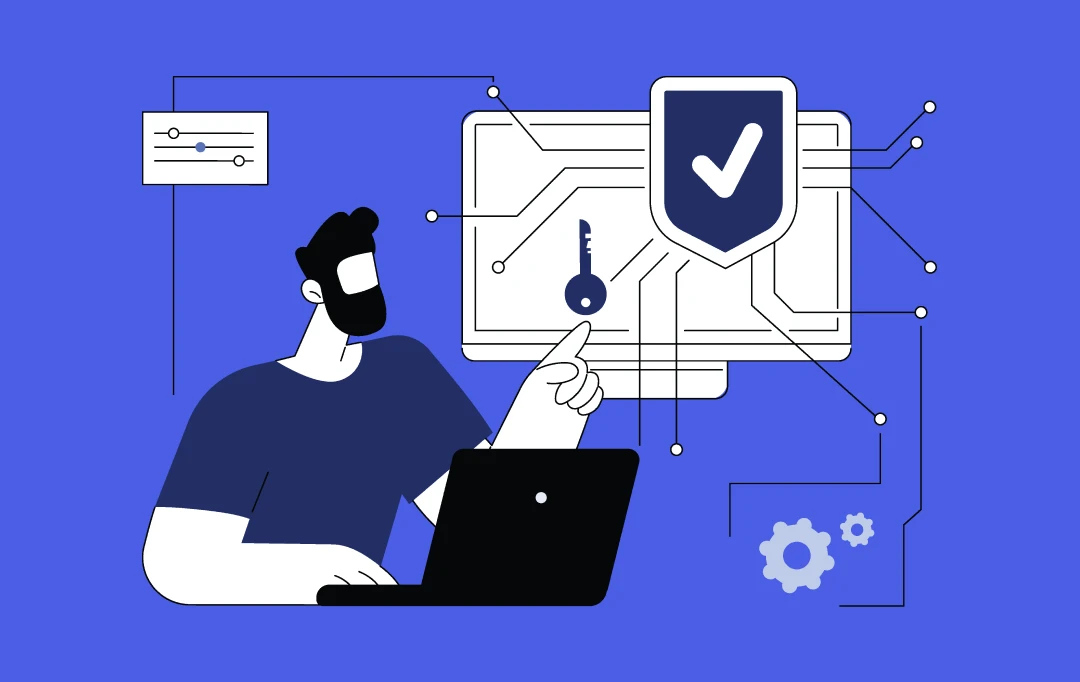
IT Compliance for Australian Businesses: Strategies, Standards & Tools to Stay Ahead in 2025
Key takeaways: IT compliance is essential for Australian businesses, fostering resilience, trust, and scalability beyond just avoiding penalties. Proactively investing in compliance reduces security risks, legal issues, and operational disruptions, enabling growth. Automation tools like GRC platforms and automated audits streamline compliance processes, saving time and minimizing errors. Legacy systems, complex regulations, and limited resources…














